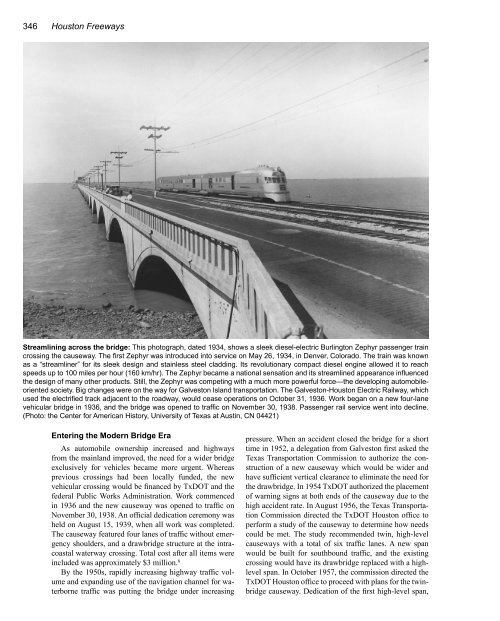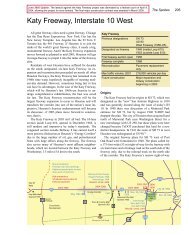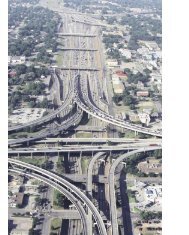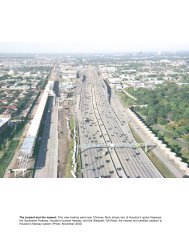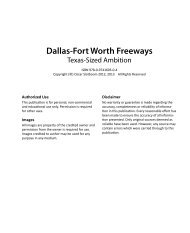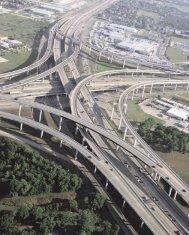Create successful ePaper yourself
Turn your PDF publications into a flip-book with our unique Google optimized e-Paper software.
346 Houston FreewaysStreamlining across the bridge: This photograph, dated 1934, shows a sleek diesel-electric Burlington Zephyr passenger traincrossing the causeway. The first Zephyr was introduced into service on May 26, 1934, in Denver, Colorado. The train was knownas a “streamliner” for its sleek design <strong>and</strong> stainless steel cladding. Its revolutionary compact diesel engine allowed it to reachspeeds up to 100 miles per hour (160 km/hr). The Zephyr became a national sensation <strong>and</strong> its streamlined appearance influencedthe design of many other products. Still, the Zephyr was competing with a much more powerful force—the developing automobileorientedsociety. Big changes were on the way for Galveston Isl<strong>and</strong> transportation. The Galveston-Houston Electric Railway, whichused the electrified track adjacent to the roadway, would cease operations on October 31, 1936. Work began on a new four-lanevehicular bridge in 1936, <strong>and</strong> the bridge was opened to traffic on November 30, 1938. Passenger rail service went into decline.(Photo: the Center for American History, University of Texas at Austin, CN 04421)Entering the Modern Bridge EraAs automobile ownership increased <strong>and</strong> highwaysfrom the mainl<strong>and</strong> improved, the need for a wider bridgeexclusively for vehicles became more urgent. Whereasprevious crossings had been locally funded, the newvehicular crossing would be financed by TxDOT <strong>and</strong> thefederal Public Works Administration. Work commencedin 1936 <strong>and</strong> the new causeway was opened to traffic onNovember 30, 1938. An official dedication ceremony washeld on August 15, 1939, when all work was completed.The causeway featured four lanes of traffic without emergencyshoulders, <strong>and</strong> a drawbridge structure at the intracoastalwaterway crossing. Total cost after all items wereincluded was approximately $3 million. 8By the 1950s, rapidly increasing highway traffic volume<strong>and</strong> exp<strong>and</strong>ing use of the navigation channel for waterbornetraffic was putting the bridge under increasingpressure. When an accident closed the bridge for a shorttime in 1952, a delegation from Galveston first asked theTexas Transportation Commission to authorize the constructionof a new causeway which would be wider <strong>and</strong>have sufficient vertical clearance to eliminate the need forthe drawbridge. In 1954 TxDOT authorized the placementof warning signs at both ends of the causeway due to thehigh accident rate. In August 1956, the Texas TransportationCommission directed the TxDOT Houston office toperform a study of the causeway to determine how needscould be met. The study recommended twin, high-levelcauseways with a total of six traffic lanes. A new spanwould be built for southbound traffic, <strong>and</strong> the existingcrossing would have its drawbridge replaced with a highlevelspan. In October 1957, the commission directed theTxDOT Houston office to proceed with plans for the twinbridgecauseway. Dedication of the first high-level span,


